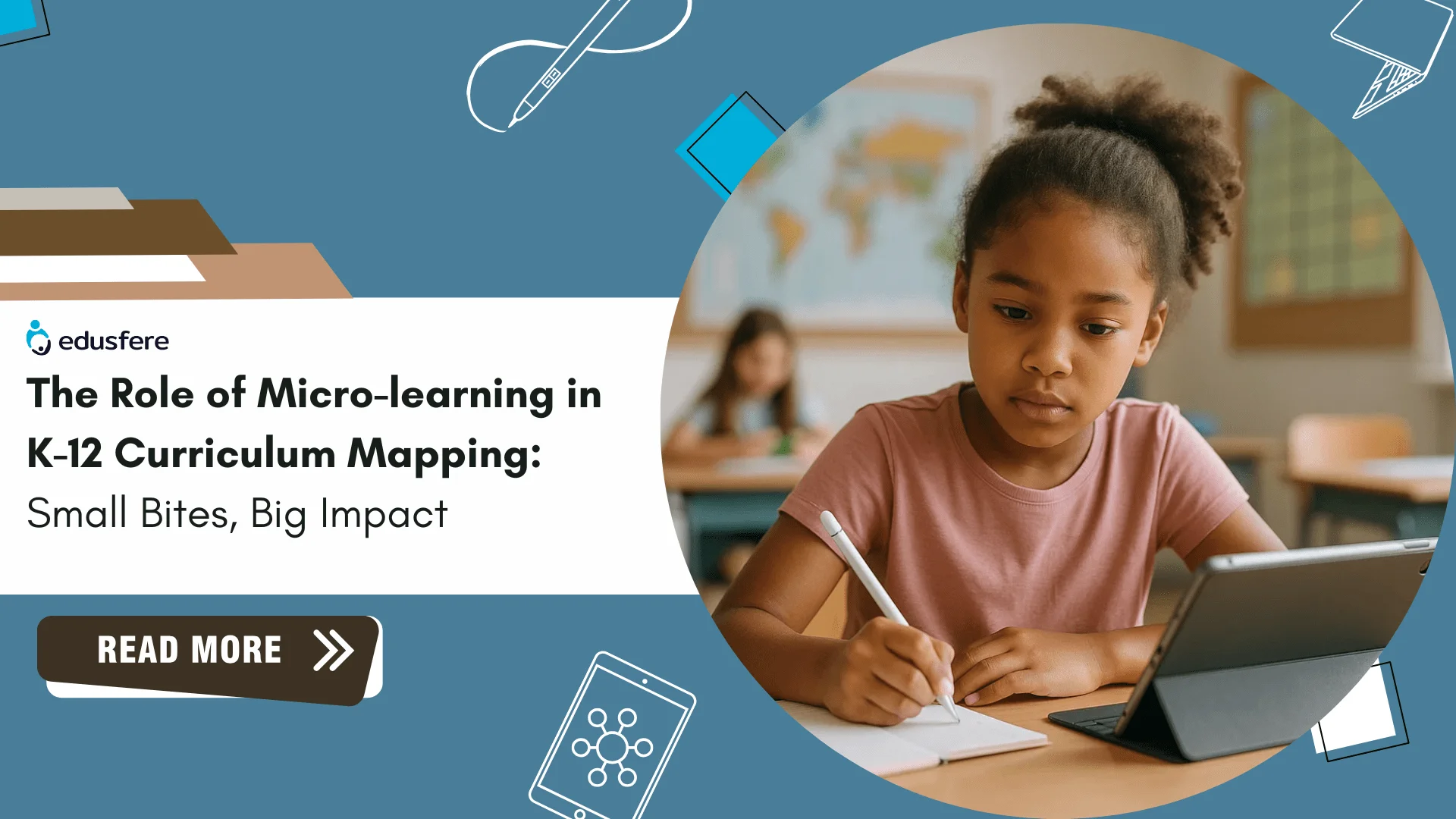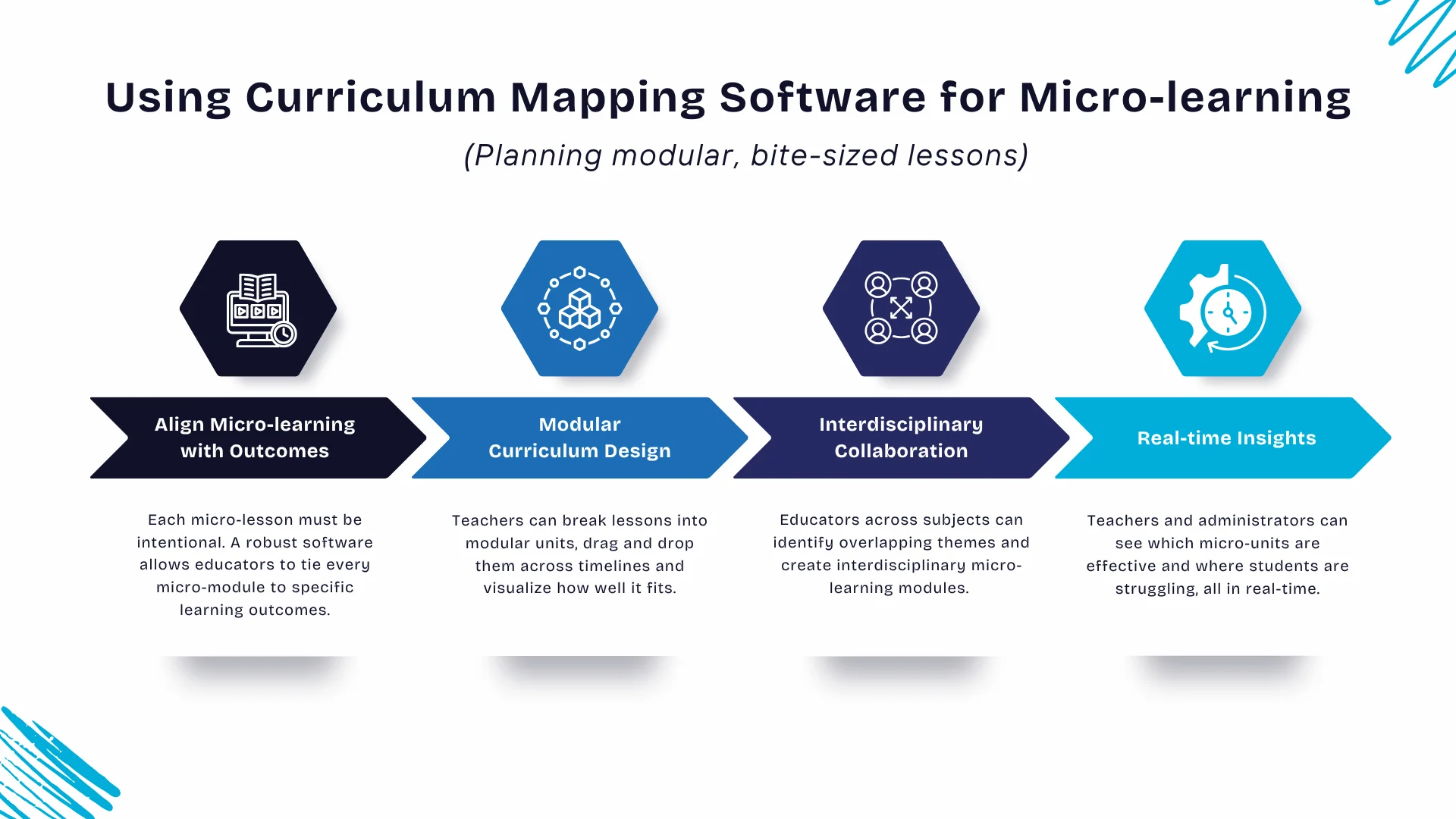Schedule a free demo to learn more
The Role of Micro-learning in K-12 Curriculum Mapping: Small Bites, Big Impact
24th June 2025

“Miss Johnson, can we watch that 3-minute video again?”
This is something we often hear in modern day classrooms and welcome it. Why? Because that tiny video on the water cycle, no longer than a commercial break, just helped 27 fifth graders grasp a concept that took a week to explain through textbooks last year.
This isn’t an isolated experience. Across the country, from urban classrooms in Chicago to smaller districts in Wyoming, educators are leaning into micro-learning – short, focused learning modules in order to captivate students and deepen learning.
But there’s more to this shift than just snappy videos and quick quizzes. Micro-learning, when embedded thoughtfully into curriculum mapping and supported by powerful curriculum mapping software, can transform not just what students learn but how they learn.
Let’s understand how this approach is changing the K-12 landscape, why schools need to think long-term and how platforms like Edusfere are turning this philosophy into practical, trackable progress.
What is Micro-learning and why it’s gaining traction in K-12 Curriculum Mapping
Micro-learning is the process of delivering educational content in small, focused units that address one learning objective at a time. These ‘learning bites’ usually last between 3 to 10 minutes and are highly visual, interactive or gamified. While once seen as a corporate training trend, micro-learning is now being embraced by K-12 educators for several reasons:
• Students are Digital Natives
According to Pew Research in 2024, 95% of teens in the U.S. have access to a smartphone and they consume content in short, fast-paced formats like YouTube Shorts and TikTok.
• Shrinking Attention spans
A research published in Nature Communications shows a steady decline in attention spans across digital media users, particularly among students aged 10 to 17.
• Flexibility is key in Blended Classrooms
With the rise of hybrid learning, asynchronous tools and flipped classrooms, educators need modular content that students can access on-demand. Micro-learning doesn’t replace comprehensive instruction but enhances it. When used strategically, it allows educators to reinforce concepts, introduce topics or offer remediation in a way that’s aligned with how students learn best.
How Micro-learning Enhances Curriculum Mapping: Engagement, Retention and Flexibility
When integrated into intentional curriculum mapping, micro-learning becomes more than just digital candy. It contributes meaningfully to learning outcomes.
1. Increased Student Engagement
When it comes to capturing attention in today’s classrooms, bite-sized learning is more than a tech trend, it’s a pedagogical shift backed by research.
Micro-learning modules are often interactive, multimedia-rich and tailored to bite-sized attention spans. These traits help students feel more in control and less overwhelmed. In fact, a 2025 systematic review published in Education Sciences confirms that micro-learning in K-12 “has great potential to increase student engagement, improve information retention and promote greater flexibility” in both digital and blended learning environments.
2. Better Retention through Spaced Repetition
Cognitive research supports the “spacing effect,” which suggests that content delivered in small doses over time results in better long-term retention. Micro-learning capitalizes on this by layering knowledge in bite-sized chunks, making it easier to revisit and reinforce.
3. Supports Personalized and Competency-based Learning
Micro-units make it easier to implement differentiation in instruction. Students can progress at their own pace, revisit content as needed and master one objective before moving to the next, which is one of the key principles in personalized learning.
Using Curriculum Mapping Software to Plan Modular, Bite-Sized Lessons
Micro-learning doesn’t exist in a vacuum. To ensure it aligns with standards and contributes to broader learning goals, it must be embedded within a larger curriculum mapping framework. Here’s where modern curriculum mapping software makes all the difference.
Read more: The ROI of Curriculum Mapping Software; What School Leaders Need to Know
1. Aligns Micro-learning with Standards and Outcomes
Each micro-lesson must be intentional. A robust curriculum mapping software allows educators to tie every micro-module to specific learning standards and outcomes, ensuring consistency across grades and subjects.
2. Modular Curriculum Design made Practical
Teachers can break lessons into modular units, drag-and-drop them across timelines and visualize how micro-learning fits into long-term planning. This modularity allows for flexible pacing, reordering or even repurposing content based on student progress or unexpected disruptions (like snow days or school closures).
3. Encourages Interdisciplinary Collaboration
With curriculum mapping tools, educators across subjects can identify overlapping themes and create interdisciplinary micro-learning modules. For example, a ‘climate change’ micro-unit might involve science, geography and language arts, offering a 360-degree learning experience.
Also Read: How are Teachers using Curriculum Mapping to Design More Effective Lessons?
4. Offers Real-time Insights
Good curriculum mapping software enables data-driven decision-making. Teachers and administrators can see which micro-units are effective, which need reworking and where students are struggling- all in real time.
How Edusfere supports Curriculum Mapping for Micro-learning across Subjects
At the forefront of this transformation is Edusfere, a curriculum mapping platform built specifically for modern K-12 schools. Here’s how Edusfere supports micro-learning across the learning lifecycle:
• Design with Precision
Teachers can easily create micro-units within Edusfere, each linked to state or national standards, learning objectives and assessments. The platform’s intuitive design ensures that every lesson, no matter how short, fits into the larger curriculum map.
• Organize with Flexibility
Edusfere enables educators to organize and tag micro-learning content by topic, subject, grade level or skill. This makes it easy to build learning pathways, sequence instruction and scaffold concepts over time.
Read more: How to Choose the Right Curriculum Mapping Software for Your School
• Collaborate Across Classrooms
Teachers can share, borrow or co-create micro-units, turning curriculum development into a collaborative experience.
Micro-learning and Curriculum Mapping: A Strategic Shift in K-12 Instruction
If there’s one takeaway for school leaders, it’s this: micro-learning isn’t just a classroom tactic, it’s a strategic shift in how we think about curriculum design and delivery. In order to harness its full potential, schools need:
- A clear curriculum mapping strategy that supports modular design
- Purpose-built curriculum mapping software that enables real-time visibility and collaboration.
- A school-wide culture that values continuous feedback, personalization and digital pedagogy
That’s the K-12 future Edusfere is helping shape.
Ready to Transform your Curriculum Mapping Strategy with Micro-learning?
Edusfere is built for K-12 educators who believe curriculum mapping should be intuitive, modular and insight-driven.
From tracking micro-learning progress to designing collaborative curriculum maps, Edusfere brings everything under one intelligent platform, so teachers can spend more time teaching and students can spend more time learning.
Schedule a demo and see how Edusfere powers flexible, modern curriculum management.
